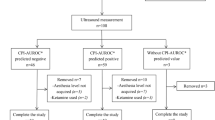Abstract
Hypotension subsequent to spinal anesthesia occurs in a significant number of parturients undergoing lower segment caesarian section. Currently available methods to predict the incidence of hypotension, its severity and the outcome are sub-optimal. Many workers have used basal heart rate as one of the predictors. But using this method it is not possible to objectively analyze and predict the extent and severity of hypotension. We used an equipment measuring the level of sympatho-vagal balance, ANSiscope™, which derives these values from computed value of RR interval variability. We made a single measure of the value which was blinded to the patient and the anesthesiologist. We studied one hundred eight patients who underwent lower segment caesarian section under spinal anesthesia and found the variability of preoperative ANSindex (% activity displayed by the equipment) from 9 to 65 %. Higher ANSindex value was significantly associated with post spinal hypotension (p 0.017). A value of 24 % indicated the critical level above which hypotension appeared commonly. The ANSindex value might help anesthesiologist to anticipate and prepare for hypotension that is likely to ensue.





Similar content being viewed by others
References
Kuo CD, Chen GY, Yang MJ, Lo HM, Tsai YS. Biphasic changes in autonomic nervous activity during pregnancy. Br J Anaesth. 2000;84:323–9.
Mitra JK, Roy J, Bhattacharyya P, Yunus M, Lyngdoh NM. Changing trends in the management of hypotension following spinal anesthesia in cesarean section. J Postgrad Med. 2013;59:121.
Mercier FJ, Augè M, Hoffmann C, Fischer C, Le Gouez A. Maternal hypotension during spinal anesthesia for caesarean delivery. Minerva Anestesiol. 2013;79:62–73.
Kee WDN, Khaw KS, Lee BB, Lau TK. GinT. A dose response study of prophylactic intravenous ephedrine for the prevention of hypotension during spinal anesthesia for cesarean delivery. Anesth Analg. 2000;90:1390–5.
Kluger MT. Ephedrine may predispose to arrhythmias in obstetric anaesthesia (letter). Anaesth Intensive Care. 2000;28:336.
Phelan JP. Pulmonary edema in obstetrics. Obstet Gynecol Clin N Am. 1991;18:319–31.
Sharwood-Smith G, Drummond GB. Hypotension in obstetric spinal anesthesia: a lesson from pre-eclampsia. Br J Anaesth. 2009;102:291–4.
Langesaeter E, Rosseland LA, Stubhaug A. Continuous invasive blood pressure and cardiac output monitoring during caesarean delivery: a randomized, double-blind comparison of low-dose versus high-dose spinal anesthesia with intravenous phenylephrine or placebo infusion. Anesthesiology. 2008;109:856–63.
Dyer RA, Reed AR, van Dyk D, et al. Hemodynamic effects of ephedrine, phenylephrine, and the coadministration of phenylephrine with oxytocin during spinal anesthesia for elective cesarean delivery. Anesthesiology. 2009;111:753–65.
Holmes F. Collapse from spinal anesthesia in pregnancy. Anaesthesia. 1959;14:204.
Frolich AM, Caton D. Baseline heart rate may predict postspinal hypotension in prehydrated obstetric patients. Can J Anaesth. 2002;49:185–9.
Chamchad D, Arkoosh VA, Horrow JC, et al. Using heart rate variability to stratify risk of obstetric patients undergoing spinal anesthesia. Anesth Analg. 2004;99:1818–21.
Hanss R, Bein B, Ledowski T, et al. Heart rate variability predicts severe hypotension after spinal anesthesia for elective cesarean delivery. Anesthesiology. 2005;102:1086–93.
Lafitte MJ, Fèvre-Genoulaz M, Srikanta SS, Punitha L, Vidyanand S. Heart beats for assessing diabetic autonomic neuropathy. Int J Diabetes Dev Ctries. 2005;25:113–7.
Bishop DG. Predicting spinal hypotension during caesarean section. S Afr J Anaesth Analg. 2014;20:170–3.
Dahlgren G, Granath F, Wessel H, Irestedt L. Prediction of hypotension during spinal anesthesia for cesarean section and its relation to the effect of crystalloid or colloid preload. Int J Obstet Anesth. 2007;16:128–34.
Kinsella SM, Norris MC. Advance prediction of hypotension at cesarean delivery under spinal anesthesia. Int J Obstet Anesth. 1996;5:3–7.
Orbach-Zinger S, Ginosar Y, Elliston J, et al. Influence of preoperative anxiety on hypotension after spinal anesthesia in women undergoing Caesarean delivery. Br J Anaesth. 2012;109:943–9.
Jeon YT, Hwang JW, Kim MH, et al. Positional blood pressure change and the risk of hypotension during spinal anesthesia for cesarean delivery: an observational study. Anesth Analg. 2010;111:712–5.
Hanss R, Bein B, Francksen H, et al. Heart rate variability-guided prophylactic treatment of severe hypotension after subarachnoid block for elective cesarean delivery. Anesthesiology. 2006;104:635–43.
Nani FS, Torres MLA. Correlation between the body mass index (BMI) of pregnant women and the development of hypotension after spinal anesthesia for cesarean section. Rev Bras Anestesiol. 2011;61:21–30.
Brenck F, Hartmann B, Katzer C, et al. Hypotension after spinal anesthesia for cesarean section: identification of risk factors using an anesthesia information management system. J Clin Monit Comput. 2009;23:85–92.
Acknowledgments
We acknowledge the assistance of Ms Anitha, our technician in assisting us with collection of data.
Author information
Authors and Affiliations
Corresponding author
Ethics declarations
Conflict of interest
None.
Rights and permissions
About this article
Cite this article
Prashanth, A., Chakravarthy, M., George, A. et al. Sympatho-vagal balance, as quantified by ANSindex, predicts post spinal hypotension and vasopressor requirement in parturients undergoing lower segmental cesarean section: a single blinded prospective observational study. J Clin Monit Comput 31, 805–811 (2017). https://doi.org/10.1007/s10877-016-9906-9
Received:
Accepted:
Published:
Issue Date:
DOI: https://doi.org/10.1007/s10877-016-9906-9




